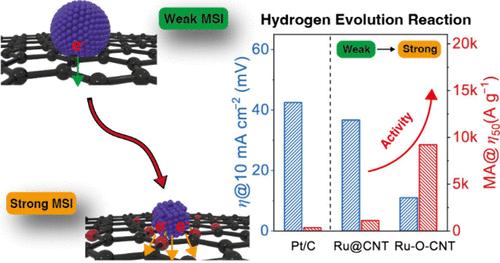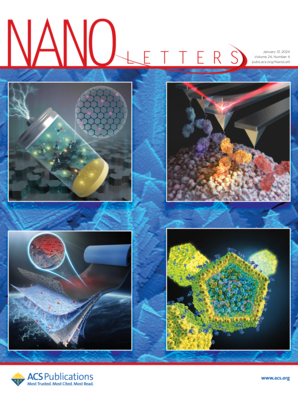Enhancing Alkaline Hydrogen Evolution by Regulating H and OH Binding Strength through Strong Metal–Support Interactions
IF 9.6
1区 材料科学
Q1 CHEMISTRY, MULTIDISCIPLINARY
引用次数: 0
Abstract
Establishing optimized metal–support interaction (MSI) between active sites and the substrate is essential for modulating the adsorption properties of key reaction intermediates during catalysis, thereby enhancing the catalytic performance. In this study, catalyst composites with varying degrees of MSI are constructed using ruthenium (Ru) and different carbon nanotubes, and their performance for alkaline hydrogen evolution reaction (HER) is systematically investigated. Detailed kinetic assessments reveal that catalysts with a strong MSI exhibit superior HER activity. For instance, Ru-O-CNT catalyst composite demonstrates an encouragingly low overpotential of 11 mV at 10 mA cm–2 and excellent stability. Electrochemical voltammetry analysis indicates that an effective MSI optimizes the binding strength of both *H and *OH, accelerating the HER process. Furthermore, we showcase that an industrial-level electrolyzer, assembled using Ru-O-CNT as the cathodic catalyst, achieves impressive performance with a low cell voltage of 1.72 V and high stability at a current density of 1 A cm–2.

通过强金属载体相互作用调节H和OH结合强度促进碱性氢的析出
在活性位点和底物之间建立优化的金属-支撑相互作用(MSI)对于调节催化过程中关键反应中间产物的吸附特性,从而提高催化性能至关重要。本研究利用钌(Ru)和不同的碳纳米管构建了具有不同程度 MSI 的催化剂复合材料,并系统地研究了它们在碱性氢进化反应(HER)中的性能。详细的动力学评估表明,具有强 MSI 的催化剂具有更高的氢进化活性。例如,Ru-O-CNT 复合催化剂在 10 mA cm-2 条件下的过电位低至 11 mV,而且稳定性极佳。电化学伏安分析表明,有效的 MSI 可优化 *H 和 *OH 的结合强度,从而加速 HER 过程。此外,我们还展示了使用 Ru-O-CNT 作为阴极催化剂组装的工业级电解槽,该电解槽在电流密度为 1 A cm-2 时具有 1.72 V 的低电池电压和高稳定性,性能令人印象深刻。
本文章由计算机程序翻译,如有差异,请以英文原文为准。
求助全文
约1分钟内获得全文
求助全文
来源期刊

Nano Letters
工程技术-材料科学:综合
CiteScore
16.80
自引率
2.80%
发文量
1182
审稿时长
1.4 months
期刊介绍:
Nano Letters serves as a dynamic platform for promptly disseminating original results in fundamental, applied, and emerging research across all facets of nanoscience and nanotechnology. A pivotal criterion for inclusion within Nano Letters is the convergence of at least two different areas or disciplines, ensuring a rich interdisciplinary scope. The journal is dedicated to fostering exploration in diverse areas, including:
- Experimental and theoretical findings on physical, chemical, and biological phenomena at the nanoscale
- Synthesis, characterization, and processing of organic, inorganic, polymer, and hybrid nanomaterials through physical, chemical, and biological methodologies
- Modeling and simulation of synthetic, assembly, and interaction processes
- Realization of integrated nanostructures and nano-engineered devices exhibiting advanced performance
- Applications of nanoscale materials in living and environmental systems
Nano Letters is committed to advancing and showcasing groundbreaking research that intersects various domains, fostering innovation and collaboration in the ever-evolving field of nanoscience and nanotechnology.
 求助内容:
求助内容: 应助结果提醒方式:
应助结果提醒方式:


